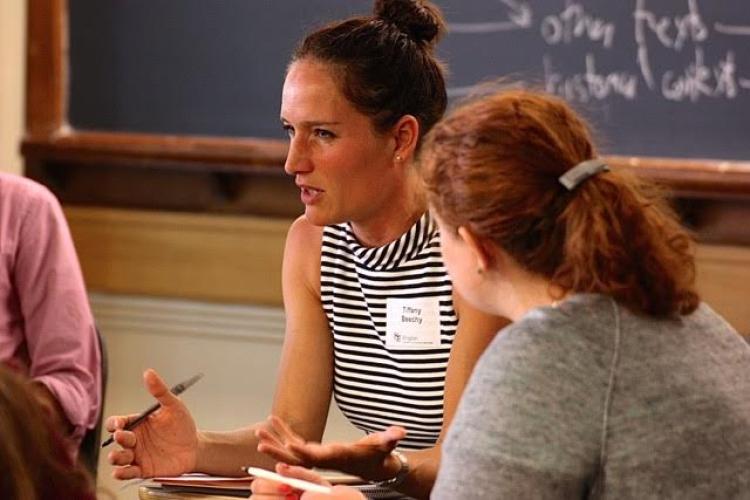Medieval monks had a great sense of humor
English professor digs into “playful and weird” medieval texts and explains how modern communication is medieval
Medieval literature is a treasure trove of weird linguistic surprises that defy classification and explanation, and University of Colorado Boulder English Professor Tiffany Beechy delights in these linguistic curiosities, even if she can’t quite explain why they’re all there.
Beechy says these surprises exist in secular and religious texts in part because of the oral tradition of English, which in the 10th century “was something that was palpable, almost material.”
When this oral tradition and the robust practice of religious poetry fused, “Anglo-Saxons saw the Word [the Bible] glitter.”
Feats of orality—from Homer’s epic poetry to the recited laws of Iceland—relied on “encod[ing] important documents into a form that [was] memorable,” Beechy says.
This strategy of oral cultures becomes unnecessary in literate societies. However, upon converting to Christianity and acquiring written language, the Anglo-Saxons still had an impulse to “code” everything from literature to law.
These encodings resulted in surprisingly playful and poetic texts, such as the Dialogue of Solomon and Saturn, a poem written by Christian monks in the 10th century. In this poem, the pagan god Saturn asks King Solomon to prove that the Pater Noster [Lord’s Prayer] is powerful.
Instead of responding in an expected orthodox way, “Solomon creates an acrostic with the Lord’s Prayer: every letter needed to spell out the prayer comes to life in the text, doing battle with the devil and beating him up. It’s almost like a cartoon sequence,” Beechy says.
Language is a thing we don’t have full control over, that we don’t use [entirely] consciously. We may think we control it, but we don’t.”
These seemingly out-of-place metaphors led previous scholars to dismiss the poem as childish and ridiculous.
But Beechy says this is a quintessential example of how the Anglo-Saxons adopted Christianity and the written word in a “residually oral way,” applying their oral understanding of language to the religion.
“In Christianity, Christ himself is the Word,” Beechy says. In this poem, the words of the Lord’s Prayer derive their power from being spoken by Christ, the Word.
Because “Christ is the word…he exists in each of the letters of the Lord’s Prayer” and the letters of the prayer become “personified superheroes” with both a physical and a Christ-like power.
The British monks in the 10th century, influenced by oral tradition, wrote this poem to examine what it meant that their new religion, and god was a word.
“They were actually taking parts of scripture and playing with those words, and trying to think through how these enigmatic, strange things could be true,” Beechy says.
Medieval English texts also include mystifying mistakes and irregularities.
Mistakes in Christian texts were especially dangerous, Beechy says, because, as a religion of the Book, grammar could be a matter of Heaven or Hell, salvation or damnation.
Since religious understanding relied on scriptures, which were encoded versions of God’s truth, the religious authorities believed they could only learn God’s will by accurately deciphering sentences from scripture.
“If you were off track or wrong on a point of doctrine, you were leading to heresy and hell,” Beechy says.
Because of the weightiness acquired by language, small, authoritative, and often heavy-handed in-crowds developed in medieval European monasteries.
This is an image of a page from the Dialogue of Solomon and Saturn, a poem written by Christian monks in the 10th century, a work that Tiffany Beechy teaches.
Perhaps it was this intense pressure and the seriousness of grammar that led these somber groups to frequently dissolve into “eruptions of [word] play and playful irreverence.” These instances fly in the face of the stereotypes of the Middle Ages: old-fashioned, orthodox, and boring, Beechy says.
The often-anonymous or pseudonymous results of their playful irreverence included riddles, forgeries, and fake grammars or language rulebooks.
These jokes, including forged travelogues by nonexistent saints, may have been a way for monks to “let off steam and just have fun,” Beechy says.
Parodies and jokes were often assimilated into somber religious texts until it became impossible to tell “what was real and what written in jest.” This mixing of narratives, Beechy says, is a continuation of the malleable oral tradition.
All these complex layers perplex scholars, but Beechy relishes even these mysteries. Unlike academics who have long ignored material they could not make sense of, she says, “I don’t think we should just extract the serious stuff and think the crazy stuff doesn’t matter.”
This acceptance and embrace of the organic, uncontrollable and surprising quality of language characterizes Beechy’s work as a scholar and professor.
“Language is a thing we don’t have full control over, that we don’t use [entirely] consciously,” she says. “We may think we control it, but we don’t.”
Instead of presenting English as dead, prescriptive, or rule-based, Beechy teaches English grammar “as having a living anatomy.”
Students participate enthusiastically in her interactive Old English classes, where grammar is “really alive.”
It is here that students begin to understand “why English has a crazy structure. This makes them the opposite of snobs, because language is something every single person owns,” she says.
Beechy says academics see society as again becoming “medieval” in the way it produces texts and art through the Internet.
In the Middle Ages, oral knowledge was an “ephemeral, fluid, transitory thing,” and the knowledge of the monks was also fluid, compiled collaboratively.
The idea of a living body of knowledge endured until the invention of the printing press. From then on, the idea of literature has existed as something closed and fixed in a final form.
But now that technology has again made literature “fluid, malleable, editable, we’re closing a historical parenthesis,” Beechy says.
And despite concerns about loosening academic and editorial standards, she says the ability to collaborate in real time is very exciting.



